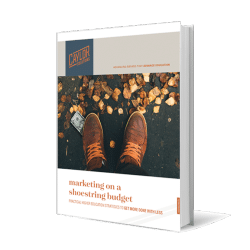Enrollment as a Turnaround Strategy: Leading a Proactive Recovery in Higher Ed
How Bethany College used enrollment as a turnaround strategy to overcome a $5M crisis—shifting from crisis management to mission-driven growth.
Featured
Even today, there’s still a lot of reticence among higher ed marketers to fully adopt generative AI tools in their enrollment strategies.
At this point, everyone is playing around with ChatGPT, and everyone has been amused by the kinds of pictures that AI can generate.
I’m sure you’re using ChatGPT to help you draft website copy and social media posts, for example.
But many higher ed marketers have a deep sense of discomfort at the thought of investing more into their knowledge and skill in leveraging generative AI to automate their marketing efforts.
I completely understand how they feel.
Doing the same thing and expecting a different result just isn’t a realistic strategy.
 In this episode of The Higher Ed Marketer podcast, Gil Rogers, Founder and Principal of GR7 Marketing, joins us to talk about the scary reality facing higher ed marketers.
In this episode of The Higher Ed Marketer podcast, Gil Rogers, Founder and Principal of GR7 Marketing, joins us to talk about the scary reality facing higher ed marketers.
But we also talk about the incredible opportunity that generative AI presents for all of us in enrollment marketing.
Over the course of this conversation, Gil unpacks how legacy strategies can hold institutions back and why embracing new tools like generative AI is essential for success.
He also highlights practical steps institutions can take to face the impending enrollment cliff, including bold strategies to adapt and remain competitive.
Read on to learn more about how generative AI can help you reach your enrollment goals without blowing up your already tight marketing budget!
Higher education marketers are no strangers to fear when it comes to trying new strategies.
As Gil Rogers points out, many of the tried-and-true methods—like buying search names, attending recruitment fairs, or investing in billboard advertising—offer a sense of comfort.
These legacy strategies are familiar, creating a kind of psychological safety net.
Even when data suggests that these approaches are less effective, the fear of abandoning them is hard to shake.
Nobody gets fired for buying more search names. Right? They get fired when they try a bunch of new things and don’t hit their enrollment goals.
For a lot of institutions, you’re only as good as your last enrollment cycle for enrollment leaders. And so, if you try too many new things and you don’t knock it out of the park, then that puts you at risk.
However, with the climate we’re currently in, there is no option to not try new things because we’re seeing that there are outside factors that are driving the need for change.
As Gil explains, external factors like the looming enrollment cliff and evolving student expectations demand urgent changes.
Institutions can’t afford to sit back and rely on outdated methods that no longer resonate with prospective students.
The stakes have shifted, and marketers must adapt to a new reality where innovation is the key to survival.
While the weight of experimenting with new strategies feels heavy—especially when entire departments depend on enrollment outcomes—marketers must take the leap.
Bold actions, even with the risk of failure, are essential.
Higher ed leaders have to reframe failure not as the end but as an opportunity to learn and iterate forward.
After all, staying rooted in the past only guarantees one thing: being left behind.
When it comes to emerging technologies, Gil emphasizes that generative AI is here to stay.
“Generative AI isn’t a fad,” Gil jokes. “It’s not going anywhere, just like the internet or social media didn’t. If you think it is, it’s time to find a new field.”
Institutions should stop seeing AI tools as mere toys for rewriting emails or brainstorming catchy subject lines.
Instead, they should leverage AI to streamline enrollment operations, focusing human resources on relationship-building while letting technology handle repetitive administrative tasks.
There are ways to use technology to be more efficient and effective in our work, specifically in enrollment and admissions, with better engagement with students. I’m not talking about just automated chatbots on websites.
What I’m talking about is using these tools and resources to do what old school predictive modeling has been doing forever that can now be updated and more effective with the use of technology.
Imagine a world where we can take our human resources that were [held up] at the top of the funnel and reallocate those resources to the middle and the bottom of the funnel. Let the robots do the work on the prospecting side!
How do we deploy the technology to get the redundant tasks and questions out of the way so that your counseling staff can do a better job at engagement at middle and bottom of the funnel?
Leverage the technology to identify the students who are a good fit for the institution, engage them, and provide them with information.
I agree with Gil on this.
Generative AI and predictive AI can help identify the most promising applicants, automating parts of the recruitment funnel so that your staff can focus on personal interactions with prospective students.
Let the co-bots do the top-of-the-funnel grunt work. Then you can concentrate on the relationship building.
The enrollment cliff—a significant drop in student numbers projected for the next few years—poses an existential threat for many colleges and universities.
Gil offers practical strategies for mitigating the impact:
“We need to shift from simply filling dorms to finding mission-fit students,” Gil asserts. “It’s time to be proactive, offering programs that meet today’s demand and ensuring our messaging resonates with the right audiences.”
How can institutions ensure that automation and generative AI do not erode the human connections essential to higher education?
Gil likens this to what happened with Starbucks—once a beloved brand for personalized experiences, now struggling as automation has depersonalized the customer journey.
“People pay for experiences, not just products,” Gil explains. “We need to make sure AI enhances, not replaces, the personal touch in higher education.”
The key, Gil advises, is to deploy generative AI strategically—using it to augment human interactions rather than replace them.
For example, AI can identify the mission-fit students, but counselors must take over to cultivate meaningful relationships.
Our conversation with Gil closed with a call to action for higher ed marketers: embrace bravery.
There is a huge push towards cutting marketing and enrollment in order to save on costs. But doing so would provoke even greater problems.
If you cut back on your sales force and your marketing outreach, you’re going to then go into a death spiral because you don’t have enough people in the field or you’re not doing enough to raise awareness and visibility.
[If you don’t have the right awareness and visibility], you’re not getting the applications you need, [which means] you’re not going to hit your goals and you’re going to cut back even further. Now you’re in this unstoppable death spiral.
To stop this “death spiral,” Gil challenges schools to ask different, more risky questions that will shake things up.
Can we add apprenticeship programs? Can we add in programs that have guaranteed outcomes?
Because that’s what people are questioning concerning the value and quality of higher education. Is it worth the investment? Can we add programs that demonstrate that it’s worth the investment?
It’s so critical that we all work together because it’s going to get rough over the next couple of years as the enrollment cliff becomes more and more of a reality for more schools.
Listen to our full interview with Gil Rogers to get even more insights into:
Leverage the Power of Generative AI
As I said, it’s going to get rough over the next few years for a lot of schools.
Fewer prospective students are looking for the higher education offer, and still more are unwilling to pay the high tuition costs necessary for the degree.
We’re already seeing schools closing their doors for the last time as enrollment has decreased to the point of unsustainability.
But this doesn’t have to be your story!
This masterclass is normally broken up into two days of three hours each day.
On Day 1 we focus on learning AI best practices with basic to advanced prompt design. We also introduce all of the current best AI tools with lots of time for Q&A.
On Day 2, we workshop “real-life” use cases straight from your team.
The best thing you’ll get from this masterclass?
The courage to do something that could save your institution during these trying times.
So, act now! Contact us today to see if the Generative AI Masterclass is right for your team.
Set yourself free from your shrinking marketing budget with my popular ebook Marketing on a Shoestring Budget! This ebook is jammed with practical ways to produce high-quality marketing on the cheap.
Inside, I’ll show you proven marketing tactics like…
No hype. No pie in the sky. Just real solutions for getting the job done with the budget you’ve got.
Featured image by Shawn Tron via Adobe Stock
Subscribe to The Higher Ed Marketer podcast today!